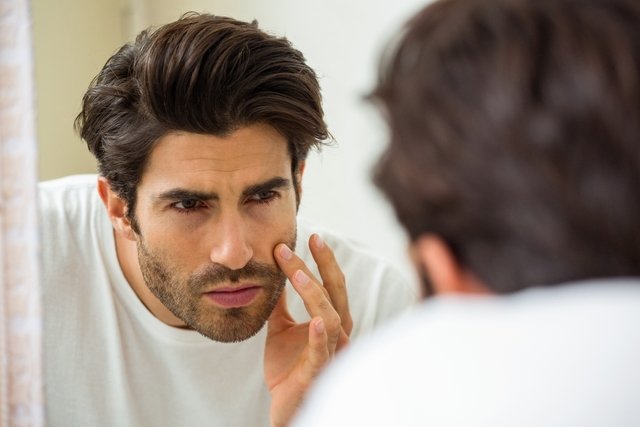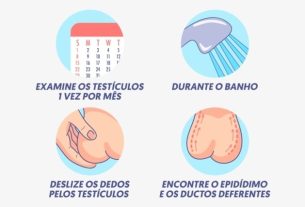Folliculitis in the beard, or pseudofolliculitis barbae, is an inflammation of the hair follicle, which is the structure in the skin where the hair roots are located, making it difficult for the hair to come out on the surface of the skin, and leading to the appearance of symptoms, such as red dots on the skin. skin, itching or burning sensation, for example.
This inflammation appears, in most cases, after shaving the beard with a razor, and can affect the face or neck, and, in some cases, can become infected by bacteria, and lead to the appearance of balls or abscesses filled with pus.
In most cases, beard folliculitis ends up disappearing over time and with some basic care, such as regularly washing the affected area with cold water and mild or antibacterial soap, for example. However, in cases where it does not improve, is frequent or blisters with pus appear, you should consult a dermatologist who can recommend the most appropriate treatment.

Symptoms of beard folliculitis
The main symptoms of beard folliculitis are:
- Red dots on the skin;
- Redness in the beard area;
- Intense itching of the skin;
- Increased skin sensitivity;
- Burning sensation;
- Small blisters with pus, similar to pimples.
Beard folliculitis can appear in one or more hair follicles, and also cause swelling or discomfort in the region and even the appearance of spots on the skin.
Furthermore, in some cases, a deeper or chronic infection may occur in the hair follicle, called sycosis barbae, which can leave scars on the skin or cause permanent hair loss in the affected region.
How to confirm the diagnosis
The diagnosis of folliculitis in the beard is made by a general practitioner or dermatologist, through evaluation of symptoms, health history and physical examination of the skin of the face and neck.
In some cases, to identify the cause of folliculitis in the beard, such as a fungal, viral or bacterial infection, the doctor may collect a sample of the liquid from the ball on the skin to be analyzed in the laboratory.
Possible causes
Beard folliculitis is caused by inflammation in the upper part of the hair follicle, which is located close to the surface of the skin, and is in most cases associated with bacterial infection. Staphylococcus aureuswhich can be found naturally in the skin.
Additionally, although less common, beard folliculitis can be caused by a fungal infection, such as Candida albicansor viruses, such as herpes simplex, for example.
Some factors can increase the risk of developing beard folliculitis, such as:
- Wounds, cuts or micro-cuts in the skin when shaving with a razor or waxing;
- Use of contaminated slides;
- Ingrown hair;
- Use of products that may cause skin irritation;
- A very large beard, which makes it difficult to properly clean the skin.
Furthermore, beard folliculitis may develop more frequently in people with a weakened immune system or who have other health conditions, such as diabetes, infections or skin damage, for example.
How the treatment is carried out
In most cases, folliculitis in the beard ends up healing over the days, with simple measures, such as regularly washing the affected area with cold water and mild or antibacterial soap, and keeping the skin clean and dry.
However, when symptoms do not improve after 1 to 2 weeks or when the balls contain pus and cause pain, it is recommended to consult a dermatologist, who may recommend the use of medications, such as:
- Antibioticsin the form of ointments, lotions or gels, such as neomycin, clindamycin, mupirocin or fusidic acid, to combat bacteria;
- Corticosteroidsin the form of an ointment, such as hydrocortisone, to relieve redness and itching of the skin;
- Oral antiviralssuch as acyclovir, valacyclovir or famciclovir, in the case of herpes simplex virus infections;
- Oral antifungalssuch as fluconazole or itraconazole, in the case of fungal infections.
In some cases, the doctor may combine the use of antibiotic ointments and corticosteroids, or even prescribe antibiotics in tablet form, such as ampicillin, sulfamethoxazole and trimethoprim, or ciprofloxacin, for example.
Furthermore, laser hair removal can also be a good treatment option for those who regularly suffer from folliculitis barbae, as the laser used in hair removal emits a wavelength that damages the hair, thus reducing the appearance of inflammation and hair. ingrown.
How to prevent its appearance
To prevent the appearance of folliculitis beard, there are some tips that can make all the difference, such as:
- Shaving only once a week;
- Use a new blade every time you shave;
- Always cut your beard in the direction of hair growth;
- Avoid passing the blade over the same place twice;
- Apply a moisturizing cream after shaving;
- In case of inflammation, avoid bursting the blister that forms, and it is not recommended to try to pull out the hair.
Additionally, exfoliation can also help remove dead skin cells and prevent ingrown hairs. See what the treatment for ingrown hairs should be like.
Pseudofolliculitis can also appear in women, especially in areas with stronger and thicker hair where razor hair removal was carried out, such as the groin and armpits.
Bibliography
- KIRSTEN, H.; et al. Tinea barbae profunda due to Trichophyton mentagrophytes : Case report and review. Dermatologist. 70.8; 601-611, 2019
- PATEL, T.S.; DALIA, Y. Pseudofolliculitis Beard. JAMA Dermatol. 158. 6; 708, 2022
- BEHERA, B.; et al. Dermoscopy of Viral Folliculitis of the Beard: Report of Two Cases. Dermatol Pract Concept. 12. 2; e2022055, 2022
- CLEBACK, K. T.; MALONE, M. A. Skin Infections. First Care. 45. 3; 433-454, 2018



